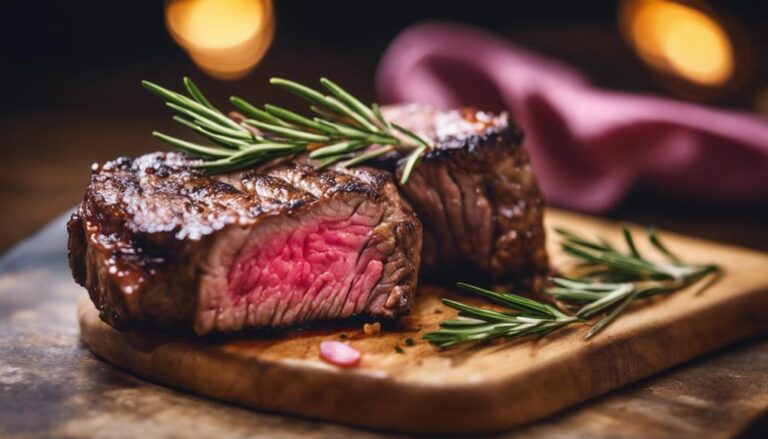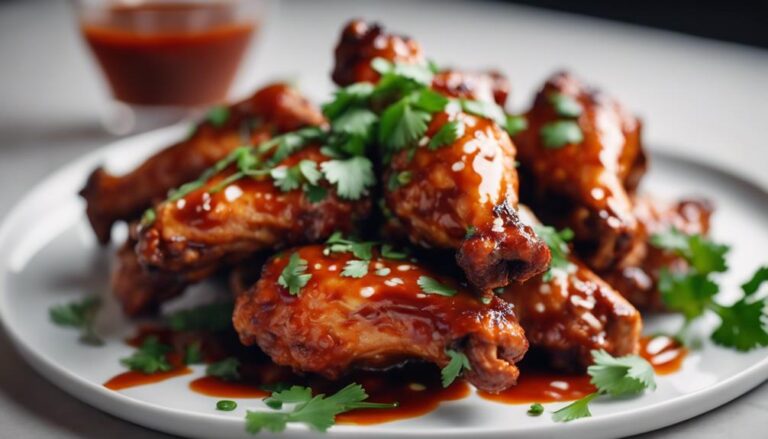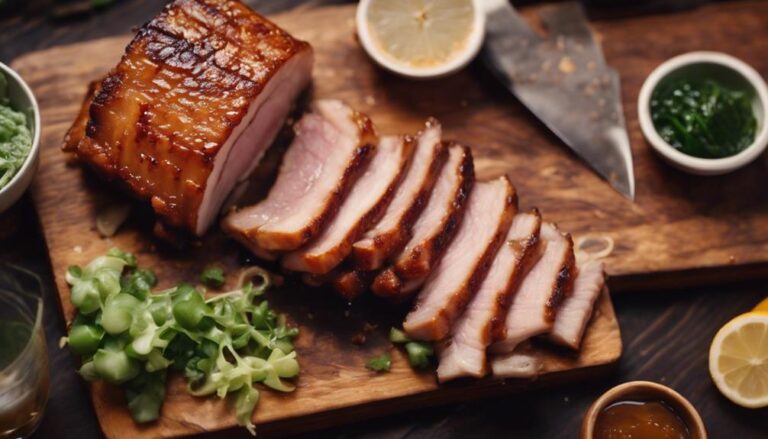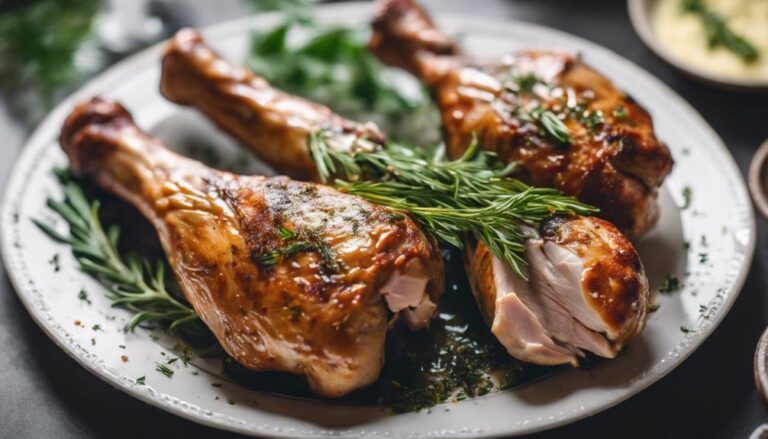Hearty Sous Vide Meat Stew: No Veggies Allowed
Step into a world of savory delights with a hearty sous vide meat stew that's all about the meat. No veggies could steal the show here. Embrace the rich flavors and tender textures as the meat takes center stage, cooked to perfection in a sous vide bath. Sealing in all the succulent juices, this stew is a celebration of meaty goodness. But that's just the beginning of this culinary adventure…
What You Will Learn Here
- Sous vide meat stew focuses on rich, meaty flavors without vegetables.
- Searing meat before sous vide enhances flavor depth.
- Bold seasonings like black pepper and garlic powder add taste layers.
- Maillard reaction during searing develops savory complexity.
- Proper searing provides texture and color contrast for an appetizing stew.
Sous Vide Origins
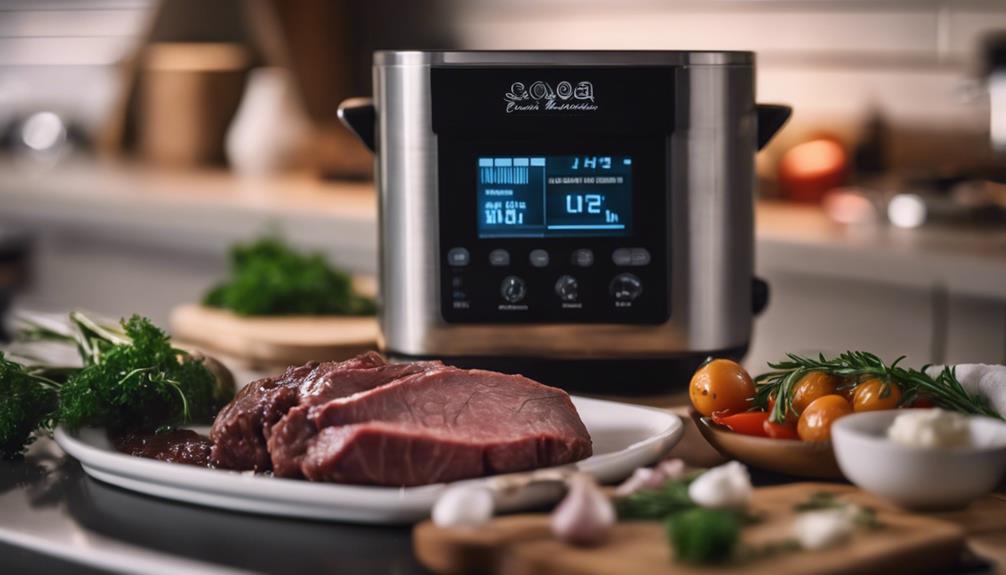
Sous Vide, a cooking method that has garnered popularity in recent years, has a rich history that dates back to the 18th century.
The evolution of the technique from laboratory use to mainstream culinary applications has been significant in shaping modern gastronomy.
Understanding the origins of sous vide sheds light on its versatility and the endless possibilities it offers in the kitchen.
Sous Vide History
Have you ever wondered about the origins of the groundbreaking culinary technique known as sous vide? Originally developed in France, sous vide, meaning "under vacuum," combines traditional French cuisine with modern technology to create perfectly cooked dishes. This method involves vacuum-sealing food in a bag and cooking it in a precisely controlled water bath at low temperatures for an extended period. Let's take a closer look at the evolution of sous vide:
| Sous Vide History | Key Points |
|---|---|
| Origin | French cuisine and modern technology |
| Development | Fine-dining restaurants adopted the technique |
| Popularity | Spread to home kitchens with affordable sous vide machines |
| Benefits | Retains flavors and nutrients, precise cooking results |
| Future Trends | Integration into various cooking appliances |
Understanding the history of sous vide can deepen your appreciation for this innovative cooking method.
Technique Evolution
The evolution of sous vide technique from its origins in French cuisine to its current widespread adoption in both professional and home kitchens showcases a remarkable culinary transformation. Sous vide advancements have revolutionized the way meat is cooked, ensuring precise temperature control for extended periods. This method results in unparalleled meat tenderness that's hard to achieve through traditional cooking methods.
By vacuum-sealing ingredients and immersing them in a precisely heated water bath, chefs can now consistently produce tender, juicy cuts of meat with perfect doneness. The meticulous process of sous vide cooking has elevated the culinary experience, allowing for unparalleled control over the final product's texture and flavor.
As the technique continues to evolve, chefs are constantly exploring new ways to enhance meat tenderness and overall dining satisfaction.
Culinary Applications
With origins rooted in French culinary tradition, the application of sous vide cooking has fundamentally transformed the way meat is prepared and enjoyed. This innovative technique allows for precise temperature control, ensuring that the meat is cooked to perfection every time.
One of the significant benefits of sous vide cooking is the ability to infuse meats with flavorful seasonings, enhancing the taste and creating a truly exceptional dining experience. Additionally, sous vide cooking isn't limited to savory dishes; it has also made its mark on the world of desserts.
Essential Meat Selections
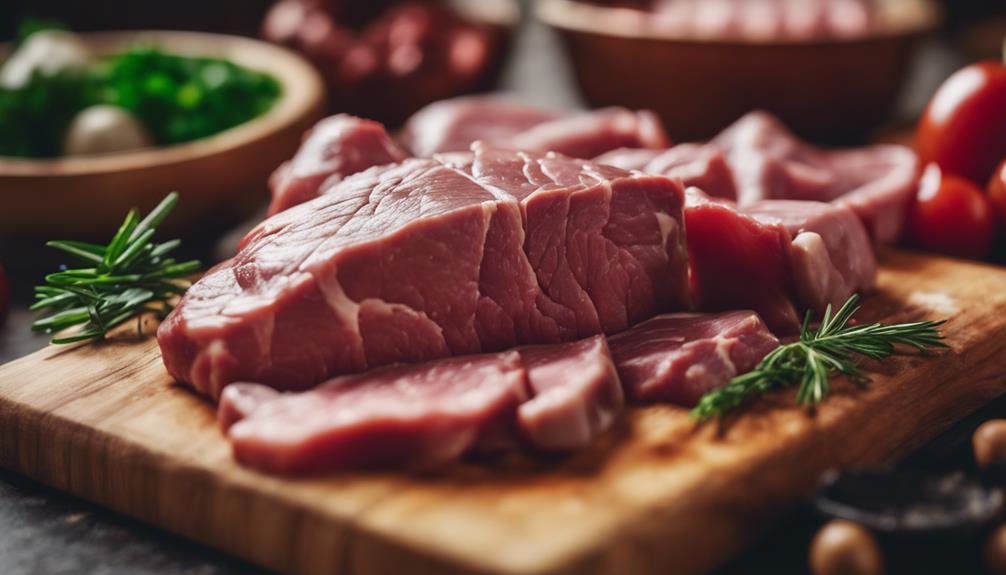
When selecting meats for your hearty sous vide stew, consider the importance of choosing cuts with a good balance of marbling and tenderness. The right meat can make all the difference in creating a flavorful and succulent dish that will impress your guests.
Here are some essential meat selections to elevate your sous vide stew:
- Beef Short Ribs: Known for their rich flavor and tender texture, beef short ribs are perfect for long sous vide cooking times, resulting in meat that falls off the bone.
- Lamb Shoulder: With a good amount of fat marbling, lamb shoulder becomes incredibly tender when cooked sous vide, offering a unique and robust flavor profile.
- Pork Belly: This fatty cut benefits from low and slow cooking, becoming melt-in-your-mouth tender while retaining its indulgent pork flavor.
- Duck Legs: Duck legs are ideal for sous vide preparations, as the method renders the meat tender and moist, enhancing the rich taste of duck.
- Chicken Thighs: Juicy and flavorful, chicken thighs hold up well to sous vide cooking, staying moist and succulent, perfect for pairing with robust sauces or spices.
Meat-Centric Sous Vide Creations
Explore the world of meat-centric sous vide creations with tantalizing options like the Meatball Sous Vide Surprise, the rich and tender Savory Sous Vide Brisket, and the succulent Sous Vide Pork Chops.
Each dish offers a unique take on sous vide cooking, showcasing the versatility and precision this method brings to meat preparation.
From comforting classics to innovative flavor combinations, these recipes are sure to elevate your sous vide culinary adventures.
Meatball Sous Vide Surprise
Nestled within the world of meat-centric sous vide creations lies the tantalizing surprise of Meatball Sous Vide. This innovative dish takes the humble meatball to new heights, infusing it with flavors and tenderness that traditional cooking methods often struggle to achieve.
Here are five key aspects that make Meatball Sous Vide a must-try:
- Perfectly Cooked: Sous vide techniques guarantee that every meatball is cooked precisely to the desired level of doneness.
- Moist and Juicy: The vacuum-sealed bags lock in moisture, resulting in meatballs that are incredibly juicy and flavorful.
- Enhanced Flavors: By cooking the meatballs in their own juices, the flavors are intensified, creating a truly decadent experience.
- Consistent Texture: Say goodbye to dry, unevenly cooked meatballs. Sous vide ensures a consistent, tender texture throughout.
- Customizable Seasonings: With sous vide, you can easily infuse your meatballs with a variety of herbs and spices, elevating them to gourmet status.
Savory Sous Vide Brisket
Savor the succulent tenderness of Savory Sous Vide Brisket, a pinnacle of meat-centric sous vide creations that promises an unparalleled dining experience. The smoky brisket, cooked to perfection, offers a melt-in-your-mouth sensation that will leave your taste buds tingling with delight.
Each tender meatball of brisket is infused with rich flavors, making every bite a savory adventure worth savoring. The sous vide technique guarantees that the brisket retains its juiciness, creating a dish that's both flavorful and moist.
Whether served as a standalone dish or paired with complementary sides, this smoky brisket will surely elevate your culinary journey.
- Succulent tenderness
- Smoky brisket flavor
- Moist and juicy meatball
- Rich infusion of flavors
- Culinary delight
Sous Vide Pork Chops
Leaving behind the succulent tenderness of Savory Sous Vide Brisket, we now turn our attention to the exquisite domain of Sous Vide Pork Chops, a delectable addition to the array of meat-centric sous vide creations.
When it comes to Sous Vide Pork Chops, the key lies in achieving that perfect balance of flavors and textures. Here are some essential tips to make sure your Sous Vide Pork Chops are a culinary delight:
- Precision Timing: Cook your pork chops at the precise temperature and duration for that perfectly juicy result.
- Seasoning Magic: Infuse your chops with a blend of spices and herbs for an explosion of flavors.
- Searing Technique: Master the art of searing to create a flavorful crust.
- Resting Period: Allow your chops to rest before serving to lock in juices and tenderness.
- Accompaniments: Pair your pork chops with complementary sides to elevate the dining experience.
Searing for Flavor
When searing meat after sous vide cooking, you're intensifying flavors and creating a rich, caramelized crust. The Maillard reaction, responsible for the browning effect, plays an essential role in developing depth and complexity in taste.
Not only does searing enhance flavors, but it also impacts the texture and color of the meat, elevating the overall dining experience.
Enhancing Meat Flavors
To achieve a rich depth of flavor in your meat stew, consider searing the meat before starting the sous vide cooking process. Searing the meat creates a beautiful crust that locks in juices, enhancing the meat infusion as it cooks slowly in the sous vide. This process helps develop a more intense and complex flavor profile.
When searing, make sure to use bold seasonings like cracked black pepper, smoked paprika, and garlic powder to add layers of taste to your stew. The caramelization that occurs during searing not only boosts flavor but also adds a pleasant color and texture to the meat.
Maillard Reaction Importance
Consider the Maillard reaction's essential role in searing meat for flavor enhancement in your sous vide cooking process.
This browning process is vital for developing rich and complex flavors in your meat stew.
When you sear the meat before or after sous vide cooking, you aren't only enhancing the taste but also adding depth to the overall dish.
The Maillard reaction occurs when the proteins and sugars on the meat's surface react under high heat, creating new flavor compounds that contribute to a more savory and robust taste profile.
This step is fundamental in elevating the taste of your stew and ensuring that every bite is packed with delicious umami notes.
Mastering this cooking method will without a doubt lead to a more satisfying culinary experience.
Texture and Color Impact
Enhancing the texture and color of your sous vide meat stew through expert searing techniques is essential for maximizing flavor impact.
When you sear the meat after sous vide cooking, you create a beautiful caramelized crust that not only adds depth to the flavor but also provides a satisfying texture contrast to the tender interior.
The Maillard reaction that occurs during searing enhances the overall taste profile by introducing complex, savory notes.
Additionally, the rich brown color achieved through proper searing enhances the visual appeal of your stew, making it more appetizing and enticing.
Final Thoughts
In concluding your culinary journey with this Hearty Sous Vide Meat Stew, reflect on the harmonious blend of flavors and tender textures that have been meticulously crafted through precise cooking techniques.
The succulent meat, infused with a rich, savory broth, showcases a depth of flavor profiles that dance on your taste buds with each spoonful. The sous vide method has unquestionably elevated this stew to a new level, ensuring that every bite is tender, juicy, and bursting with umami goodness. The ingredient combinations, carefully selected to enhance the natural essence of the meat, have proven to be a winning formula for a hearty and satisfying meal.
As you savor the last spoonful, consider how your taste preferences have been met and exceeded by this flavorful stew. The slow cooking process has allowed the meat to reach peak tenderness while locking in all the juices and aromas, resulting in a truly unforgettable dining experience.
This hearty sous vide meat stew, with its robust flavors and melt-in-your-mouth textures, is a tribute to the artistry of cooking and a delight for those you serve.
Frequently Asked Questions
Can Vegetables Be Added to the Meat Stew?
Yes, vegetables can be added to the meat stew to provide more flavor and nutrients. Vegetable alternatives can enhance the dish, but for veggie-free options, stick to herbs and spices for a robust taste.
How Long Should I Sous Vide the Meat?
For peak tenderness and flavor, sous vide your meat at the recommended temperature for your specific cut. Cooking times vary based on thickness and desired doneness. Experiment to find your perfect balance!
What Searing Method Works Best for This Stew?
For the best searing tips to elevate flavor in your stew, consider using a cast-iron skillet for a crispy finish. Experiment with different cuts of meat for texture variation, enhancing the overall dining experience.
Can I Use Any Type of Meat for This Recipe?
You can explore various meat options like beef, pork, or lamb for recipe variations. Each meat brings a unique flavor profile to the stew. Experimenting with different cuts can elevate the dish's richness and depth.
Is It Necessary to Marinate the Meat Before Sous Vide Cooking?
To enhance meat tenderness and flavor infusion, marinating before sous vide cooking is advantageous. Marination techniques amplify taste and juiciness, maximizing sous vide benefits. It's essential for a mouthwatering outcome, ensuring a delectable dish.
Conclusion
Indulge in the rich, savory flavors of a hearty sous vide meat stew. Vegetables take a back seat to the star of the show – the meat. By carefully selecting the right cuts and utilizing the sous vide method, you can create tender and flavorful dishes that are sure to impress.
Searing the meat for that perfect caramelized crust adds an extra layer of depth to your culinary creation. Say goodbye to veggies and hello to a meat-centric culinary experience!






